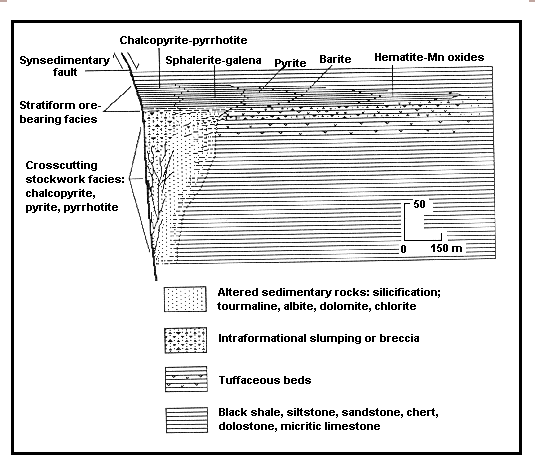
DESCRIPTIVE MODEL OF SEDIMENTARY EXHALATIVE Zn-Pb
MODEL 31a
By Joseph A. Briskey
APPROXIMATE SYNONYMS Shale-hosted Zn-Pb; sediment-hosted massive sulfide Zn-Pb.
DESCRIPTION Stratiform basinal accumulations of sulfide and sulfate minerals interbedded with euxinic marine sediments form sheet- or lens-like tabular ore bodies up to a few tens of meters thick, and may be distributed through a stratigraphic interval over 1,000 m (see fig. 158).
Figure 158. Cartoon cross section showing mineral zoning in sedimentary exhalative Zn-Pb deposits (modified from Large, 1980)

GENERAL REFERENCES Large (1980, 1981, 1983).
GEOLOGICAL ENVIRONMENT
Rock Types Euxinic marine sedimentary rocks including: black (dark) shale, siltstone, sandstone, chert, dolostone, micritic limestone, and turbidites. Local evaporitic sections in contemporaneous shelf facies. Volcanic rocks, commonly of bimodal composition, are present locally in the sedimentary basin. Tuffites are the most common. Slump breccias, fan conglomerates, and similar deposits, as well as facies and thickness changes, are commonly associated with synsedimentary faults.
Textures Contrasting sedimentary thicknesses and facies changes across hinge zones. Slump breccias and conglomerates near synsedimentary faults.
Age Range Known deposits are Middle Proterozoic (1,700-1,400 m.y.); Cambrian to Carboniferous (530-300 m.y.).
Depositional Environment Marine epicratonic embayments and intracratonic basins, with smaller local restricted basins (second- and third-order basins).
Tectonic Setting(s) Epicratonic embayments and intracratonic basins are associated with hinge zones controlled by synsedimentary faults, typically forming half-grabens. Within these grabens (first-order basins), penecontemporaneous vertical tectonism forms smaller basins (second-order basins) and associated rises. Smaller third-order basins (tens of kilometers) within the second-order basins (102-105 km) are the morphological traps from the stratiform sulfides.
Associated Deposit Types Bedded barite deposits.
DEPOSIT DESCRIPTION
Mineralogy Pyrite, pyrrhotite, sphalerite, galena, sporadic barite and chalcopyrite, and minor to trace amounts of marcasite, arsenopyrite, bismuthinite, molybdenite, enargite, millerite, freibergite, cobaltite, cassiterite, valleriite, and melnikovite.
Texture/Structure Finely crystalline and disseminated, monomineralic sulfide laminae are typical. Metamorphosed examples are coarsely crystalline and massive.
Alteration Stockwork and disseminated sulfide and alteration (silicification, tourmalization, carbonate depletion, albitization, chloritization, dolomitization) minerals possibly representing the feeder zone of these deposits commonly present beneath or adjacent to the stratiform deposits. Some deposits have no reported alteration. Celsian, Ba-muscovite, and ammonium clay minerals may be present.
Ore Controls Within larger fault-controlled basins, small local basins form the morphological traps that contain the stratiform sulfide and sulfate minerals. The faults are synsedimentary and serve as feeders for the stratiform deposits. Euxinic facies.
Weathering Surface oxidation may form large gossans containing abundant carbonates, sulfates, and silicates of lead, zinc, and copper.
Geochemical Signature Metal zoning includes lateral Cu-Pb-Zn-Ba sequence extending outward from feeder zone; or a vertical Cu-Zn-Pb-Ba sequence extending upward. NH3 anomalies may be present. Exhalative chert interbedded with stratiform sulfide and sulfate minerals; peripheral hematite-chert formations. Local (within 2 km) Zn, Pb, and Mn haloes. Highest expected background in black shales: Pb = 500ppm; Zn = 1,300 ppm; Cu = 750 ppm; Ba = 1,300 ppm; in carbonates: Pb = 9 ppm; Zn = 20; Cu = 4 pmm; Ba = 10.
EXAMPLES
Sullivan mine, CNBC (Hamilton and others, 1982)
Meggen mine, GRMY (Krebs, 1981)
Navan, Silvermines, Tynagh, IRLD (Boyce and others, 1983; Taylor, 1984)